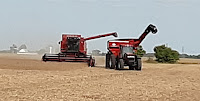Thanksgiving is like the child who
is always left behind. Tucked away in the midst of Halloween and Christmas, it
has always had to fight to get its due attention. If recent years weren’t bad
enough, this year it will be even worse because of the pandemic.
They are telling us not to gather for the holiday, to only be with your immediate household. Once again it is being stomped down and pushed aside. This holiday just can’t win.
What a shame that is because Thanksgiving is perhaps the most important holiday of all. No, not because we stuff ourselves until we are miserable, but rather because, like its namesake, it is a time to give thanks and remember our blessings.
Think about it, this holiday requires hardly any preparation except for cooking the meal which, we cooks revel in anyway. Halloween is the second most decorated holiday, only surpassed by Christmas. Many of those decorations double as harvest décor so are left up for Thanksgiving. There is no frenzy shopping, wrapping, writing tons of Christmas cards or many other tasks that we are taught need to be done every year for Christmas. It is really the no-stress holiday.
When I was growing up, no one ever thought of doing anything for Christmas until after Thanksgiving. Now as Halloween decorations come down, Christmas goes up. I will admit that it makes sense since you already have everything out, the totes, ladders, tools, etc. But still, come on, at least don’t turn the lights on.
This year I have noticed a slightly different tone as holiday decorations are going up. Many people have made comments like “I just want something cheery and happy, something to look forward to.” Hence, the early decorations. Hallmark channel started running their Christmas movies even earlier this year for this very reason.
Folks are already looking forward to New Year’s this year too, just to get 2020 behind them. But, can we at least pause and really consider Thanksgiving also? Yes, 2020 has been a bad year, but there is truth in the saying that “there is a little bad in the good and a little good in the bad.”
So, where is the good in this year? For starters, staying home this year has spurred creativity in many of us. Sometimes boredom can be a blessing. There is only so much television one can watch, so many video games one can play and (heaven forbid) only so much cooking and baking we can or should do.
So, this has been a time to discover other hidden interests. A friend has been posting creative painting videos on Facebook. I know of another one who has always wanted to try her hand at writing. Some bigger projects like learning to quilt also come to mind.
For guys that have never had the time to hunt or pursue things like woodworking, fly tying their own fishing lures, blacksmithing and a host of other projects that have been put on the back burner, this has been the time.
Many of these things have been put on the back burner because time has always been a limited commodity. These past few months have afforded us a window of opportunity to explore passions we have only dreamed about.
For many, this past year has been a glimpse of what retirement may look like. Yes, hopefully, we will be able to go and do things in a normal way again. The change associated with retirement is scary for many. I suppose in some twisted way, this can be a glimpse into the future. Some have found that they actually like being home and have also realized that life itself is too precious to put off retirement any longer. Still, others have found that they go stir crazy at home and are just not ready for this next chapter yet.
Also, in a twisted way, maybe we should be thankful this year for a new sense of family. We may not be able to physically gather, but this absence may just make us appreciate family even more. I am as guilty as anyone of spending time with family and going through the motions and really not “being” with them. We all have.
How many times has a family spent time “together” at a ballgame where each member is hanging out with others; a family is out to eat and every one of them is on their cell phones or a family has movie night where each one of them is watching a different one on their own devices.
Sad to say, lately with Zoom meetings and video chats, family is actually focusing on spending time together…sort of. It’s too bad that we can sometimes be closer to those we love when we are forced to be separated from them physically.
Perhaps this year, more so than any other year, Thanksgiving should hold an extra special place in our hearts. As a recent meme on social media reminds us, “There is always, always something to be thankful for.”
So, whatever our Thanksgiving looks like this year maybe it will help to focus on the blessings that we do have instead of what we don’t. Perhaps this year Thanksgiving will finally get its due and earn the respect that it deserves.




